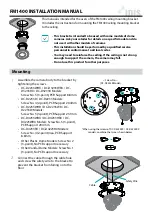
17
©
Dinel, s.r.o. RFLS–28
When installing the sensor in a metal tank or reservoir, the housing is not necessary to be grounded
separately.
In the case of the use for an aggressive medium is necessary to prove the chemical
compatibility of the materials, from which the sensor is made (see Tab. Used materials on p.
18). Any chemical damage is not covered by the warranty.
10 . Sensor variant with output "PD" with Diagnostic
10.1. Diagnostic modes
The diagnostic has one mode of error-free operation and three modes indicating a malfunction or
incorrect setting.
10.1.1. Correct measurement
INDICATION: -
green
LED flashes (approx. 0.4 s)
-
orange
LED:
when the output is closed, the LED shines
when the output is open, the LED is dark
OUTPUT: a 300 μs wide pulse with a period of
30 ms
is generated into the output signal
SENSOR STATUS: the diagnostic does not indicate any problem, the measuring curve and the
sensor settings are correct
10.1.2. Incorrect setting
INDICATION: alternating flashing
green and orange
LEDs
OUTPUT: a 300 μs wide pulse with a period of
20 ms
is generated into the output signal
SENSOR STATUS: the measuring curve is OK, but the sensor setting is incorrect (decision levels
are close to each other)
The sensor type RFLS-35_-_-_-PD has a diagnostic built in its firmware with which it monitors its
functional reliability. In order for the diagnostic to be active, i.e. the error notification to be indicated
even if the control or output circuit is not functional, the microprocessor generates short pulses to
the output signal, the so-called diagnostic pulses. Negative pulses are generated when the output is
closed and positive pulses are generated when the output is open. This ensures faultless operation
of all HW and SW components of the sensor.











































